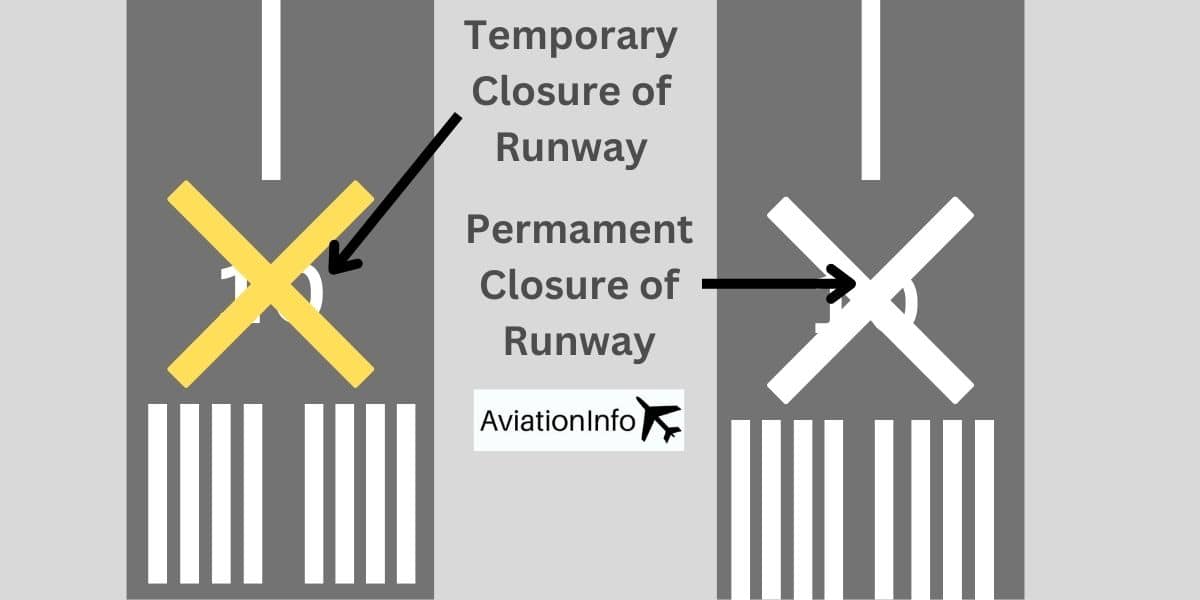As set out by the regulatory authorities, airport ground markings are used to identify and outline runways, taxiways, and airport facilities. While active taxiways and runways are typically displayed and allocated using a variety of white symbols, there are some airport marking designations that differentiate active and decommissioned runways and taxiways.
What Does an X on a Runway Mean?
As seen in the below diagram, white or yellow “Xs” are assigned to runways and taxiways which are not active or have been decommissioned. This large X is used to provide a clear, distinct symbol to air traffic on the ground or in the air of an inactive facility.

These X symbols are most typically deployed over an existing runway numbering and/or the piano key section of the pavement. On most decommissioned runways, large Xs are placed on both ends and in some instances, on the center section. This ensures that the runway is clearly marked as inactive.
What Do Yellow and White Xs on a Runway Mean?
As discussed above, X marks on a runway may be either yellow or white in color. These two colors can signal different operational indications of the runways:
- Yellow X – A yellow X on a runway is used when a runway has been temporarily withdrawn from active service. This can be actioned for several reasons, a common one being when a runway or surrounding pavement is under maintenance. This is common practice at many airports, in which runways are temporarily decommissioned during off-peak hours/seasons for repair work.
- White X – A white X on a runway is assigned to a runway or airport pavement when there is a long-term or permanent decommissioning of the infrastructure. This can be seen at airports that have permanently closed runways for re-designation of the airport ground layout – in which the runway and taxiway flow of the airfield are being modified.

White or Yellow Xs on a Taxiway

Similar to runways, taxiways can also be permanently or temporarily withdrawn from active use. While the reasons for this can vary, they are generally for similar purposes as to why runways are marked with an X.
At taxiway intersections, white or yellow Xs can also represent a “No Entry” indication – in which the adjacent taxiway has been marked as inactive. This is common practice during airport construction works, in which maintenance is being performed on a section of the taxiway.
In rarer circumstances, taxiway entry/exit points are marked with an X to signal to air traffic that the particular entry or exit point is not to be used. However, in most cases, a “No Entry” ground or taxiway marking is placed at the exit or entry point. In general, this X is used as a temporary measure to signal “No Entry”.
X on a Runway at Night
During night operations, the white X painted on the pavement is not visible. To overcome this, a flashing White X is often placed on the closed runway. This provides a visual aerial indication to air traffic that the runway is not active.
This flashing white X is generally configured in a strobe sequence, in which there are 2-second increments of ON/OFF of the white X display.
Importance of X Markings on Runways and Taxiways
The importance and essential nature of X markings on inactive runways and taxiways have been well documented.
The 2000 accident of Singapore Airlines Flight 006 in which the Boeing 747-400 flight crew mistook a closed runway in maintenance for the active runway led to 83 fatalities, highlighting the importance of clear runway and taxiway markings.
While weather conditions led to poor visibility, the accident showed the importance of flight crews having the ability to identify inactive or closed runway surfaces.
In 2006, Comair Flight 5191 lined up and departed on the incorrect, inactive runway at Lexington Airport, Kentucky. The aircraft overran the runway and killed all passengers onboard, with the First Officer being the sole survivor.
The 2007 NTSB safety report and recommendations document published the following year highlighted the importance of flight crews identifying and ensuring that the aircraft is on the correct departure runway.
The accident report highlighted the importance of situational awareness during the pre-departure phase of the flight; in which the correct taxiways and runways are followed.
While several factors contributed to this accident, the correct designation of runways and taxiways is crucial to the safe operation of aircraft prior to, during, and after becoming airborne.
Related Articles:
The Costs of Building a Runway

After visiting more than 60 countries, I have probably been on every type of plane there is and visited countless airports. I did my very first international solo trip to South Africa at the age of only 16 and haven’t really stopped traveling since.
Despite the adventurous travel itch, I do have a nerdy side as well – which is satisfied by writing about all things aviation “too boring” for my regular travel blog.
